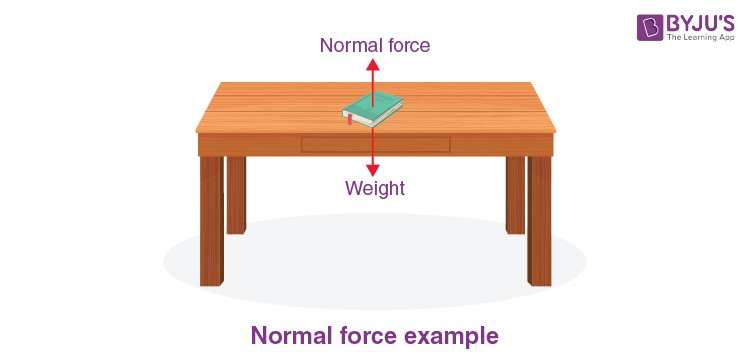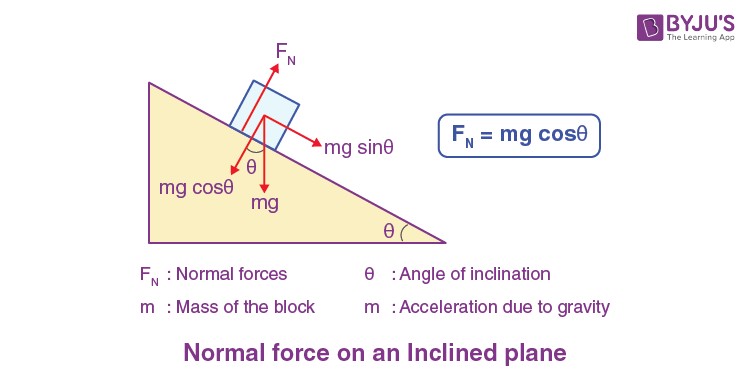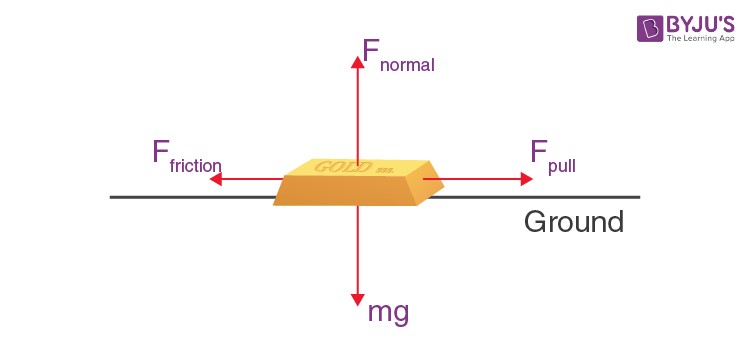What Is Normal Force? This fundamental concept in physics explained by WHAT.EDU.VN, describes the force exerted by a surface supporting an object, acting perpendicular to the surface. Delve into understanding reaction force, exploring its formula, relationship with friction, and real-world instances. We can help answer all your questions quickly.
1. Concept of Normal Force
The normal force is a contact force that arises when an object rests on a surface. It’s the force that prevents the object from sinking into the surface. The term “normal” in this context signifies perpendicularity. This force acts in a direction perpendicular to the surface of contact. Everyday life provides numerous examples of normal forces at play.
Consider placing a book on a table. Gravity pulls the book downwards, but the book doesn’t fall through the table. This is because the table exerts an upward force on the book, counteracting gravity. This upward force is the normal force. The normal force ensures the book remains stationary on the table.
Another common example involves a ball bouncing. When a ball is dropped, it accelerates downwards due to gravity. Upon impact with the ground, the ground exerts a normal force on the ball, causing it to rebound. The normal force is a non-conservative force, meaning that some of the ball’s energy is lost during the bounce, resulting in a lower rebound height. Friction also acts as a non-conservative force.
2. Normal Force Formula
The calculation of normal force depends on the situation. Here are several common scenarios and their corresponding formulas:
-
Scenario 1: Force Acting at an Angle
When a force is applied to a body at an angle θ, the normal force (FN) is larger than the object’s weight.
FN = F sin θ + mg
Where:
- θ = Angle at which the force is applied
- FN = Normal force
- m = Mass of the object
- g = Acceleration due to gravity
-
Scenario 2: Upward Force
When a body is pulled upwards by a force, the normal force (FN) is smaller than its weight.
FN = mg – F sin θ
Where:
- θ = Angle at which the body is pulled upwards
- FN = Normal force
- m = Mass of the object
- g = Acceleration due to gravity
-
Scenario 3: Object on a Flat Surface
When a body rests on a flat, horizontal surface, the normal force (FN) is equal to the object’s weight.
FN = mg
Where:
- FN = Normal force
- m = Mass of the object
- g = Acceleration due to gravity
-
Scenario 4: Object on an Inclined Plane
When a body is placed on an inclined plane, the normal force (FN) is given by:
FN = mg cos θ
Where:
- θ = Angle of the inclined plane
- FN = Normal force
- m = Mass of the object
- g = Acceleration due to gravity
3. Relationship Between Friction Force and Normal Force
Friction is a force that opposes motion between two surfaces in contact. The force of friction (Ffriction) always acts in the opposite direction to the applied force. The magnitude of the frictional force is directly proportional to the normal force.
According to the laws of physics, friction is proportional to the force pressing the two surfaces together. The stronger the normal force, the greater the force of friction. This relationship is expressed as:
Ffriction = μFN
Where:
- Ffriction = Force of friction
- μ = Coefficient of friction (a dimensionless quantity that depends on the nature of the surfaces in contact)
- FN = Normal force
Consider a gold bar resting on the ground. The weight of the gold bar (mg) acts downwards. According to Newton’s third law of motion (for every action, there is an equal and opposite reaction), the ground exerts an equal and opposite force upwards on the gold bar. This upward force, perpendicular to the surface, is the normal force. The normal force and friction force are perpendicular components of the total force exerted by the surface on the object.
4. Normal Force Examples
To solidify your understanding of normal force, let’s examine some real-world examples:
-
Example 1: A Person Standing on a Flat Surface
When a person stands on a flat surface, their weight exerts a downward force on the surface. The surface, in turn, exerts an equal and opposite upward force on the person. This upward force, acting perpendicular to the surface, is the normal force.
-
Example 2: Television Resting on a Table
When a television rests on a table, its weight exerts a downward force on the table. The table responds by exerting an upward force on the television, preventing it from falling through. This upward force, perpendicular to the table’s surface, is the normal force.
These examples illustrate that any time a force acts in a perpendicular direction to a surface, it is considered a normal force. The reactive force is also a normal force.
5. Applications of Normal Force
The concept of normal force is crucial in many areas of physics and engineering. Some key applications include:
- Structural Engineering: Engineers use the principles of normal force to design stable structures, such as buildings and bridges. Understanding how normal forces are distributed within a structure is essential to prevent collapse.
- Machine Design: Normal forces play a significant role in the design of machines and mechanical systems. For example, the normal force between a tire and the road surface is critical for traction and braking.
- Biomechanics: In biomechanics, the study of the mechanics of living organisms, normal forces are used to analyze the forces acting on joints and bones during movement.
- Geophysics: Normal forces are important in understanding the behavior of rocks and soil under stress. This is relevant to understanding earthquakes and landslides.
- Robotics: Normal force sensing is used in robotics to allow robots to interact with their environment in a controlled manner.
6. Factors Affecting Normal Force
Several factors can affect the magnitude of the normal force. These include:
- Weight of the Object: The heavier the object, the greater the normal force required to support it.
- Angle of the Surface: As seen in the inclined plane example, the angle of the surface affects the component of the weight acting perpendicular to the surface, thus affecting the normal force.
- External Forces: Any external forces acting on the object, such as a pushing or pulling force, will affect the normal force.
- Acceleration: If the object is accelerating vertically, the normal force will be different from the object’s weight. For example, if an object is in an elevator accelerating upwards, the normal force will be greater than the object’s weight.
7. Common Misconceptions About Normal Force
It’s important to address some common misconceptions about the normal force:
- Misconception 1: Normal Force is Always Equal to Weight. This is only true when the object is on a horizontal surface and no other vertical forces are acting on it.
- Misconception 2: Normal Force is Always Upwards. The normal force always acts perpendicular to the surface, so on an inclined plane, it acts at an angle.
- Misconception 3: Normal Force is a Reaction to Weight. While the normal force is related to the weight of the object, it is more accurately described as a reaction to the force that the object exerts on the surface.
- Misconception 4: Normal Force and Tension Are The Same. Normal force is the force exerted by a surface on an object in contact with it, acting perpendicularly to the surface, while tension is the force transmitted through a rope, string, or cable when it is pulled tight by forces acting from opposite ends.
8. Advanced Concepts Related to Normal Force
For a more in-depth understanding, consider these advanced concepts:
- Stress and Strain: Normal force is related to the concept of stress, which is the force per unit area acting on a material. Strain is the deformation of the material in response to stress.
- Elasticity: The normal force is related to the elasticity of the surface. Elasticity is the ability of a material to return to its original shape after being deformed.
- Contact Mechanics: Contact mechanics is the study of the deformation and stress distribution when two or more bodies come into contact. Normal force is a key concept in contact mechanics.
- Finite Element Analysis (FEA): FEA is a numerical method used to solve complex engineering problems involving stress and strain. Normal force is used as an input to FEA simulations.
9. The Importance of Accurate Normal Force Calculations
Accurate calculations of normal force are critical in many applications. For example, in structural engineering, incorrect calculations can lead to structural failures. In machine design, inaccurate calculations can result in premature wear and tear. In robotics, precise normal force control is essential for delicate tasks.
Therefore, a thorough understanding of the principles of normal force and careful attention to detail are necessary for accurate calculations.
10. Normal Force in Different Fields
- Civil Engineering: In civil engineering, the normal force is a critical consideration in the design of foundations, bridges, and other structures. Engineers must accurately calculate the normal forces acting on these structures to ensure their stability and safety. For example, when designing a bridge, engineers must consider the normal forces exerted by vehicles on the bridge deck, as well as the normal forces exerted by the bridge supports on the ground.
- Mechanical Engineering: In mechanical engineering, the normal force is important in the design of machines and mechanisms. For example, the normal force between a cam and a follower determines the contact stress and wear rate. Engineers must carefully consider the normal forces in these systems to ensure their reliability and longevity.
- Aerospace Engineering: In aerospace engineering, the normal force is a key factor in the design of aircraft and spacecraft. The normal force acting on an aircraft wing, for example, contributes to lift. Engineers must accurately calculate the normal forces on these vehicles to ensure their safe and efficient operation.
- Biomedical Engineering: In biomedical engineering, the normal force is important in the study of human movement and biomechanics. For example, the normal force between a foot and the ground is a key factor in understanding gait and balance. Biomedical engineers use normal force measurements to develop prosthetic devices and rehabilitation programs.
- Sports Science: In sports science, the normal force is used to analyze the forces acting on athletes during various activities. For example, the normal force between a runner’s foot and the ground is important for understanding running mechanics and injury prevention. Sports scientists use normal force measurements to optimize training techniques and equipment design.
Do you have burning questions about physics or any other topic? At WHAT.EDU.VN, we provide a free platform to ask any question and receive quick, accurate answers.
11. Real-World Scenarios
Understanding normal force isn’t just for textbooks; it’s applicable in numerous real-world scenarios.
- Elevators: When you ride in an elevator, you experience changes in the normal force. As the elevator accelerates upwards, the normal force exerted by the floor on your feet increases, making you feel heavier. Conversely, when the elevator accelerates downwards, the normal force decreases, making you feel lighter.
- Driving: The normal force between your car’s tires and the road is essential for traction. When you accelerate, brake, or turn, the normal force allows the tires to exert the necessary forces on the road to change your car’s motion.
- Walking: Each time you take a step, the ground exerts a normal force on your foot. This force is what allows you to push off the ground and move forward. The magnitude and direction of the normal force change throughout the gait cycle, providing information about your balance and stability.
- Sitting: When you sit in a chair, the chair exerts a normal force on your body, supporting your weight. The distribution of the normal force depends on your posture and the design of the chair.
- Stacking Objects: When you stack objects on top of each other, each object experiences a normal force from the object below it. The normal force increases as you add more objects to the stack.
12. Beyond the Basics: Considering Complex Scenarios
While the basic formulas provide a solid foundation, real-world scenarios often involve complexities that require a deeper understanding of normal force.
- Non-Uniform Surfaces: If an object rests on a non-uniform surface, the normal force may not be evenly distributed. For example, if an object rests on a surface with bumps or indentations, the normal force will be concentrated at the points of contact.
- Deformable Surfaces: If the surface is deformable, such as a mattress or a cushion, the normal force will cause the surface to deform. The amount of deformation depends on the stiffness of the surface and the magnitude of the normal force.
- Dynamic Situations: In dynamic situations, where the object is moving or accelerating, the normal force can change over time. For example, when a car goes over a bump, the normal force between the tires and the road changes rapidly.
- Multiple Contact Points: If an object is supported by multiple contact points, the normal force will be distributed among these points. The distribution of the normal force depends on the geometry of the object and the stiffness of the supports.
13. Normal Force Measurement Techniques
In many applications, it is necessary to measure the normal force directly. Several techniques are available for measuring normal force:
- Force Sensors: Force sensors, also known as load cells, are devices that convert force into an electrical signal. They can be used to measure the normal force between two objects in contact.
- Pressure Sensors: Pressure sensors measure the pressure exerted by a force over an area. They can be used to measure the distribution of normal force over a surface.
- Strain Gauges: Strain gauges measure the deformation of a material. They can be used to infer the normal force acting on the material.
- Optical Techniques: Optical techniques, such as photoelasticity and moiré interferometry, can be used to visualize the stress distribution in a material. This information can be used to determine the normal force.
14. Tips for Solving Normal Force Problems
Solving normal force problems requires a systematic approach. Here are some tips to help you succeed:
- Draw a Free-Body Diagram: Start by drawing a free-body diagram of the object. This diagram should show all the forces acting on the object, including the normal force, weight, and any applied forces.
- Choose a Coordinate System: Choose a convenient coordinate system. This will make it easier to resolve the forces into components.
- Apply Newton’s Second Law: Apply Newton’s second law of motion (ΣF = ma) to the object. This will give you a set of equations that you can solve for the normal force.
- Consider Constraints: Consider any constraints on the object’s motion. For example, if the object is resting on a surface, the normal force must be positive.
- Check Your Answer: Check your answer to make sure it makes sense. For example, the normal force should be equal to the weight of the object if the object is resting on a horizontal surface and no other vertical forces are acting on it.
15. Normal Force and Equilibrium
Equilibrium is a state where the net force and net torque acting on an object are zero. In equilibrium, the object is either at rest (static equilibrium) or moving with constant velocity (dynamic equilibrium).
Normal force plays a crucial role in maintaining equilibrium. For an object to be in equilibrium on a surface, the normal force must balance the other forces acting perpendicular to the surface, such as the weight of the object and any applied forces.
16. Examples of Normal Force in Sports
Normal force is a fundamental concept in sports biomechanics, influencing performance and injury prevention.
- Running: The normal force between a runner’s foot and the ground dictates the ground reaction force, impacting propulsion and stride mechanics. Analyzing normal force helps optimize running form and minimize impact-related injuries.
- Jumping: In jumping events like high jump or long jump, the normal force exerted by the ground during the takeoff phase is critical. A greater normal force translates to a more powerful jump.
- Skating: The normal force between the skates and the ice surface is crucial for gliding and turning. Skilled skaters manipulate their body weight and skate angle to control the normal force and achieve desired maneuvers.
- Weightlifting: During weightlifting exercises, the normal force exerted by the lifter on the barbell is equal to the weight of the barbell plus any additional force applied by the lifter. Understanding normal force helps lifters optimize their technique and prevent injuries.
- Cycling: The normal force between the bicycle tires and the road surface provides the necessary friction for propulsion and braking. Maintaining adequate normal force is essential for stability and control, particularly on uneven terrain or during cornering.
17. The Role of Normal Force in Everyday Activities
Normal force is not just a physics concept confined to textbooks and laboratories; it permeates our daily lives, influencing countless activities we often take for granted.
- Walking and Standing: Whenever you walk or stand, the ground exerts a normal force on your feet, counteracting the force of gravity and keeping you upright.
- Sitting: When you sit on a chair, the chair exerts a normal force on your body, supporting your weight.
- Writing: When you write on a piece of paper, the paper exerts a normal force on your pen, allowing you to create marks on the surface.
- Driving: The tires of a car exert a normal force on the road, providing the necessary traction for acceleration, braking, and steering.
- Cooking: When you place a pot on a stove, the stove exerts a normal force on the pot, supporting its weight and allowing it to heat up.
18. Future Directions in Normal Force Research
Research on normal force continues to evolve, driven by advancements in technology and a desire to better understand the complex interactions between surfaces. Some key areas of future research include:
- Nanoscale Normal Force: Scientists are exploring normal force at the nanoscale, using atomic force microscopy and other techniques to investigate the interactions between individual atoms and molecules.
- Tribology: Tribology is the study of friction, wear, and lubrication. Researchers are using normal force measurements to develop new lubricants and surface coatings that reduce friction and wear.
- Robotics: Normal force sensing is becoming increasingly important in robotics, enabling robots to perform delicate tasks and interact with their environment in a controlled manner.
- Biomechanics: Researchers are using normal force measurements to study human movement and biomechanics, with the goal of developing new treatments for injuries and improving athletic performance.
- Material Science: Normal force is a key parameter in material science, influencing the mechanical properties of materials and their response to stress. Researchers are using normal force measurements to develop new materials with enhanced strength and durability.
19. Normal Force vs. Other Forces
Understanding the differences between normal force and other types of forces is crucial for a comprehensive understanding of physics. Here’s a brief comparison:
| Force | Description | Direction | Example |
|---|---|---|---|
| Normal Force | The force exerted by a surface on an object in contact with it, acting perpendicularly to the surface. | Perpendicular to the surface of contact. | A book resting on a table. |
| Gravity | The force of attraction between objects with mass. | Towards the center of the object exerting the gravitational pull (usually the Earth). | An apple falling from a tree. |
| Friction | A force that opposes motion between two surfaces in contact. | Parallel to the surface of contact, opposing the direction of motion or attempted motion. | A box sliding across a floor. |
| Tension | The force transmitted through a rope, string, or cable when it is pulled tight by forces acting from opposite ends. | Along the direction of the rope, string, or cable. | A rope pulling a weight. |
| Applied Force | A force that is directly applied to an object by another object or person. | Varies depending on the direction of the applied force. | Pushing a box across the floor. |
| Buoyant Force | An upward force exerted by a fluid that opposes the weight of an immersed object. | Upward, opposing the force of gravity. | A boat floating on water. |
| Spring Force | The force exerted by a compressed or stretched spring. | Opposite to the direction of compression or stretching. | A compressed spring pushing an object. |
| Air Resistance | A force that opposes the motion of an object through the air. | Opposite to the direction of motion. | A parachute slowing down a skydiver. |
| Magnetic Force | The attractive or repulsive force between magnetic materials. | Varies depending on the magnetic field and the orientation of the magnetic materials. | A magnet attracting a paperclip. |





20. Practical Applications in Different Industries
The understanding and application of normal force are critical in various industries.
- Construction: Calculating normal forces is crucial for designing stable and safe buildings, bridges, and other structures.
- Manufacturing: Normal force considerations are essential in designing machines and equipment that can withstand the stresses and strains of manufacturing processes.
- Automotive: Normal force plays a significant role in designing vehicles that have good traction, handling, and braking performance.
- Aerospace: Understanding normal force is crucial for designing aircraft and spacecraft that can withstand the extreme forces of flight.
- Sports Equipment: Normal force is a key factor in designing sports equipment that can enhance performance and prevent injuries.
21. Interactive Examples and Demonstrations
To further enhance your understanding of normal force, consider these interactive examples and demonstrations:
- Bathroom Scale: Stand on a bathroom scale and observe how the reading changes as you lean forward, backward, or to the side. This demonstrates how the normal force changes as your center of gravity shifts.
- Inclined Plane: Place an object on an inclined plane and observe how the normal force changes as you increase or decrease the angle of the plane. This demonstrates how the normal force is affected by the angle of the surface.
- Spring Scale: Use a spring scale to measure the normal force between two objects in contact. This demonstrates how the normal force can be measured directly.
- Simulation Software: Use physics simulation software to create virtual experiments involving normal force. This allows you to explore different scenarios and gain a deeper understanding of the concept.
- Online Resources: Explore online resources such as videos, animations, and interactive simulations that illustrate the principles of normal force.
22. Normal Force and Material Properties
The magnitude of the normal force is influenced by the properties of the materials in contact. The stiffness of the surface plays a crucial role. A stiffer surface will exert a greater normal force for a given deformation, while a more compliant surface will exert a smaller normal force.
The normal force also affects the contact area between the two surfaces. As the normal force increases, the contact area may also increase, leading to a more distributed force. This is particularly important in applications involving soft or deformable materials.
23. Normal Force in Biological Systems
Normal force is not limited to inanimate objects; it also plays a crucial role in biological systems.
- Joints: The normal force between the bones in a joint is essential for load bearing and movement. The cartilage in the joint helps to distribute the normal force and reduce friction.
- Muscles: Muscles exert forces on bones, which can create normal forces at joints. These forces are essential for movement and stability.
- Skin: The skin exerts a normal force on objects that it comes into contact with. This force is important for grip and tactile sensation.
- Cell Adhesion: Cells adhere to each other and to the extracellular matrix through normal forces. These forces are essential for tissue structure and function.
24. Problem-Solving Strategies
Mastering the concept of normal force requires practice in solving a variety of problems. Here are some problem-solving strategies:
- Read the problem carefully: Identify the knowns and unknowns.
- Draw a free-body diagram: This will help you visualize the forces acting on the object.
- Choose a coordinate system: This will make it easier to resolve the forces into components.
- Apply Newton’s second law: ΣF = ma.
- Solve for the unknowns: Use algebra to solve for the unknowns.
- Check your answer: Make sure your answer makes sense and has the correct units.
25. Real-World Problem Examples and Solutions
Let’s explore a few examples of normal force problems and their solutions:
Problem 1: A 10 kg box rests on a horizontal surface. What is the normal force acting on the box?
Solution:
- Knowns:
- Mass (m) = 10 kg
- Acceleration due to gravity (g) = 9.8 m/s²
- Unknown:
- Normal force (FN)
- Free-body diagram: The forces acting on the box are gravity (downward) and the normal force (upward).
- Newton’s second law: ΣF = ma. In the vertical direction, FN – mg = 0 (since the box is not accelerating vertically).
- Solve for FN: FN = mg = (10 kg)(9.8 m/s²) = 98 N
Problem 2: A 5 kg block is placed on an inclined plane that makes an angle of 30 degrees with the horizontal. What is the normal force acting on the block?
Solution:
- Knowns:
- Mass (m) = 5 kg
- Angle of inclination (θ) = 30 degrees
- Acceleration due to gravity (g) = 9.8 m/s²
- Unknown:
- Normal force (FN)
- Free-body diagram: The forces acting on the block are gravity (downward) and the normal force (perpendicular to the inclined plane).
- Newton’s second law: ΣF = ma. In the direction perpendicular to the inclined plane, FN – mg cos θ = 0 (since the block is not accelerating in that direction).
- Solve for FN: FN = mg cos θ = (5 kg)(9.8 m/s²)(cos 30°) = 42.4 N
Problem 3: A 2 kg book is pressed against a vertical wall with a force of 20 N. What is the normal force exerted by the wall on the book?
Solution:
- Knowns:
- Applied force (F) = 20 N
- Mass (m) = 2 kg
- Unknown:
- Normal force (FN)
- Free-body diagram: The forces acting on the book are the applied force (horizontal), the normal force (horizontal, opposite to the applied force), gravity (downward), and friction (upward).
- Newton’s second law: ΣF = ma. In the horizontal direction, F – FN = 0 (since the book is not accelerating horizontally).
- Solve for FN: FN = F = 20 N
Do you have any questions about force, physics, or any other topic? Don’t hesitate to ask at WHAT.EDU.VN and receive free answers from our experts.
26. Resources for Further Learning
To further expand your knowledge of normal force, consider these resources:
- Textbooks: Consult introductory physics textbooks for detailed explanations and examples.
- Online Courses: Enroll in online courses on platforms like Coursera or edX.
- Physics Websites: Explore websites like Physics Classroom or HyperPhysics for comprehensive information.
- YouTube Channels: Subscribe to physics-related YouTube channels for visual explanations and demonstrations.
- Interactive Simulations: Use interactive simulations to explore the concept of normal force in a dynamic and engaging way.
27. Advanced Topics and Research
For those seeking a deeper dive, explore these advanced topics and research areas:
- Contact Mechanics: Delve into the complexities of contact mechanics, which examines the deformation and stress distribution when two or more bodies come into contact.
- Tribology: Study tribology, the science and engineering of interacting surfaces in relative motion, encompassing friction, wear, and lubrication.
- Finite Element Analysis (FEA): Learn about FEA, a numerical technique used to solve complex engineering problems involving stress and strain, where normal force is a critical input.
- Nanoscale Interactions: Explore the fascinating realm of nanoscale interactions, where atomic force microscopy and other techniques reveal the behavior of normal forces at the atomic level.
- Biomechanics Research: Investigate the role of normal force in biomechanics, from joint mechanics to human movement analysis.
28. The Importance of Asking Questions
The quest for knowledge begins with asking questions. Don’t hesitate to question assumptions, challenge conventional wisdom, and seek clarification on concepts that are unclear. Asking questions is essential for critical thinking, problem-solving, and intellectual growth.
At WHAT.EDU.VN, we believe that everyone should have the opportunity to ask questions and receive free answers from experts. Our platform is designed to facilitate knowledge sharing and promote a culture of curiosity and lifelong learning.
29. How WHAT.EDU.VN Can Help
At WHAT.EDU.VN, we understand the challenges students and lifelong learners face when seeking answers to their questions. That’s why we’ve created a platform that makes it easy to ask any question and receive free answers from experts.
Our platform offers:
- A user-friendly interface: Simply type your question and submit it.
- A diverse community of experts: Our experts come from a wide range of fields and backgrounds.
- Fast and accurate answers: We strive to provide answers that are both timely and informative.
- A free service: Our platform is completely free to use.
Whether you’re struggling with a homework assignment, preparing for an exam, or simply curious about the world around you, WHAT.EDU.VN is here to help.
30. Call to Action
Do you have a question about normal force, physics, or any other topic? Don’t hesitate to ask! Visit WHAT.EDU.VN today and submit your question for free. Join our community of learners and experts and embark on a journey of knowledge discovery.
We’re here to provide the answers you need, when you need them.
Contact Us:
Address: 888 Question City Plaza, Seattle, WA 98101, United States
Whatsapp: +1 (206) 555-7890
Website: what.edu.vn
Ask your question today and experience the power of free knowledge sharing!
